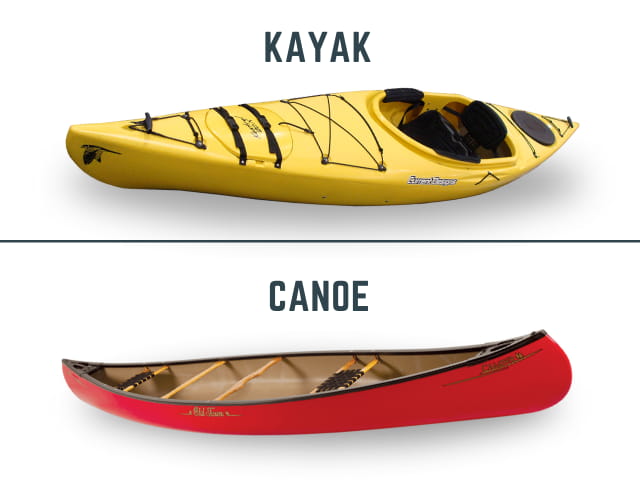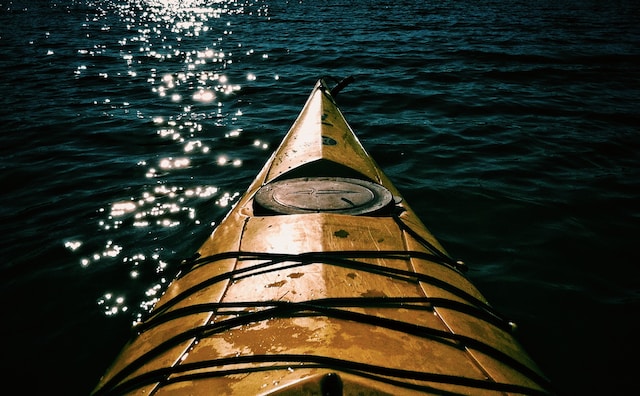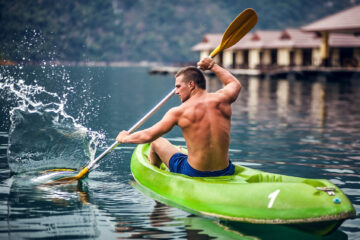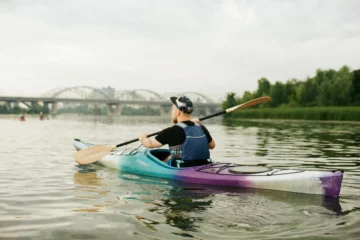Curious about Canoeing vs Kayaking? You’re in the right place. Canoeing, a traditional choice, offers a spacious open design, ideal for families or those who love to bring gear. On the other hand, kayaking boasts a smoothie profile, providing speed and agility for solo adventures.
This guide offers a clear, head-to-head comparison. Both offer unique experiences on the water. But they’re not the same. I’ll cover gear, skills, and where each shines. So whether you’re a beginner or seasoned paddler, this guide is for you. Ready to make an informed choice? Let’s get started.
Key Takeaways:
- Canoes are stable and family-friendly, while kayaks offer speed and agility.
- Consider your preferences when choosing between them.
- Ensure you have the right gear for a safe experience.
Types of Kayaks
Kayaks come in various styles, each with its purpose. These are,
| Type of Kayaks | Key Features | Best For |
| Recreational | Stable, easy to use | Beginners, calm waters |
| Touring | Long, narrow, built for distance | Long trips, open water |
| Whitewater | Short, agile | Rapids, fast currents |
| Fishing | Stable, extra storage | Anglers, calm waters |
| Inflatable | Easy to store, lighter | Casual use, easy transport |
| Tandem | Two seats | Paddling with a partner |
| Sit-on-Top | Open deck, easy to get on/off | Warm climates, easy entry/exit |
Types of Canoes
Here are some different types of canoes and what they’re good for:
| Type of Canoe | Key Features | Best For |
| Recreational | Stable, easy to paddle | Beginners, calm waters |
| Touring | Long, efficient glide | Long trips, open water |
| Whitewater | Short, robust | Rapids, fast currents |
| Fishing | Stable, extra storage | Anglers, calm waters |
| Freestyle | Highly maneuverable | Tricks, flat water |
| Multi-Purpose | Versatile design | Various activities |

What’s The Difference Between A Canoe And Kayak?
They’re both watercraft, but they’re not the same. Let’s dive into the key differences. Let’s break down the key differences.
Design and Shape
First up, design. Canoes are open on top. Kayaks are closed. Canoes are usually wider. Kayaks are narrow. This affects speed and stability.
Paddles
Next, let’s talk about paddles. Canoe paddles have one blade. Kayak paddles have two. This changes how you steer and move.
Seating Position
In a canoe, you kneel or sit on a bench. In a kayak, you sit low with your legs stretched out. Your seating affects balance and control.
Best Uses
Last but not least, usage. Canoes are great for leisure and carrying gear. Kayaks excel in speed and are good for sport.
Choosing Your Water Adventure: Canoe or Kayak?
When picking between a canoe and a kayak, think about your preferences and plans. Size, comfort, and where you’ll paddle matter.
Questions To Ask Yourself
- Do you want to paddle alone or with friends?
- Is speed or stability more crucial for you?
- What water conditions will you face?
- Will you fish on the water?
- Do you have kids with you?
- Canoe vs Kayak – Fishing For anglers, a kayak might be cozier. You sit low, better for casting. Canoes have space for gear and more room for catching big fish.
- Canoe vs Kayak – Stability If you’re new to paddling, canoes are stable. Easier for beginners and families. Kayaks can tip but are quicker once you get the hang of it.
- Canoe vs Kayak – Speed For speed demons, kayaks are like sports cars. Glide swiftly through the water. Canoes are more leisurely, and better for relaxed exploring.
- Canoe vs Kayak – Beginners Canoes are kinder to newbies. Steadier waters and more space. Kayaks need practice but offer excitement.
- Canoe vs Kayak – Families Canoe’s bigger, fit for family fun. Picnics, pets, and paddling together. Kayaks are for bonding but cozier.
Exploring the Pros and Cons
Both have their ups and downs. Let’s weigh the pros and cons to help you make an informed choice. Read on!
Pros and Cons for Canoeing
Thinking about canoeing? It’s a popular choice for many reasons. But like anything, it has its pros and cons. Let’s take a closer look.
| Pros | Cons |
| Ample Storage Space | Less Speed |
| Easy to Board | Harder to Maneuver |
| Family-Friendly | Bulky to Transport |
| Versatile Use | Not Ideal for Rough Waters |
| Stable Design | |
| Room for Extra Gear | |
| Social Experience | |
| Good for Fishing |
Pros and Cons of Kayaking
It’s a thrilling way to explore the water. However, it’s important to know both the good and the bad. Let’s dive in.
| Pros | Cons |
| Fast and Agile | Limited Storage |
| Easy to Maneuver | Harder to Board |
| Great for Sport | Less Stable |
| Compact Design | Not as Social |
| Good for Rough Waters | |
| Low to Water (Better Control) | |
| Suitable for Solo Trips | |
| Various Types Available |
Gear Essentials for Canoeing and Kayaking
Before you go into the water, make sure you have the right gear. Safety and comfort are key. Let’s dive into the essentials.
Personal Floatation Device (PFD)
First on the list is a PFD. It’s non-negotiable. Choose one that fits well and meets safety standards. It could save your life.
Paddle
You’ll need a paddle, of course. Canoe paddles have one blade. Kayak paddles have two. Pick one that suits your height and strength.
Helmet
If you’re tackling rapids or whitewater, a helmet is a must. It protects your head from rocks and other hazards.
Dry Bag
Keep your stuff dry. A dry bag is perfect for storing phones, snacks, and extra clothes. Seal it tight and keep it secure.
Footwear
Last but not least, footwear. Water shoes or sandals with grip work well. They protect your feet and provide good traction.
FAQs
What’s the Main Difference in Paddles?
Canoe paddles have one blade, while kayak paddles have two. This affects how you steer and move in the water. Kayak paddles allow for quicker, more agile movement.
Which is Better for Fishing?
Canoes offer more storage space, making them ideal for fishing trips. Kayaks are stealthier but have limited storage, making them less ideal for carrying fishing gear.
Summary
Now you know everything about Canoeing vs Kayaking! Whether you choose canoeing or kayaking depends on your preferences and plans. Canoes offer stability, ample storage, and a family-friendly experience, while kayaks provide speed, agility, and sporty adventures.
Both have their pros and cons, so consider what matters most to you. Remember to equip yourself with the right gear, including a PFD, paddle, helmet (for whitewater), dry bag, and suitable footwear. Whether you’re a beginner or a seasoned paddler, enjoy the water and stay safe!





[…] in a canoe is comfortable and easy, especially for long trips or for those who find kneeling hard. But, it can make the canoe […]